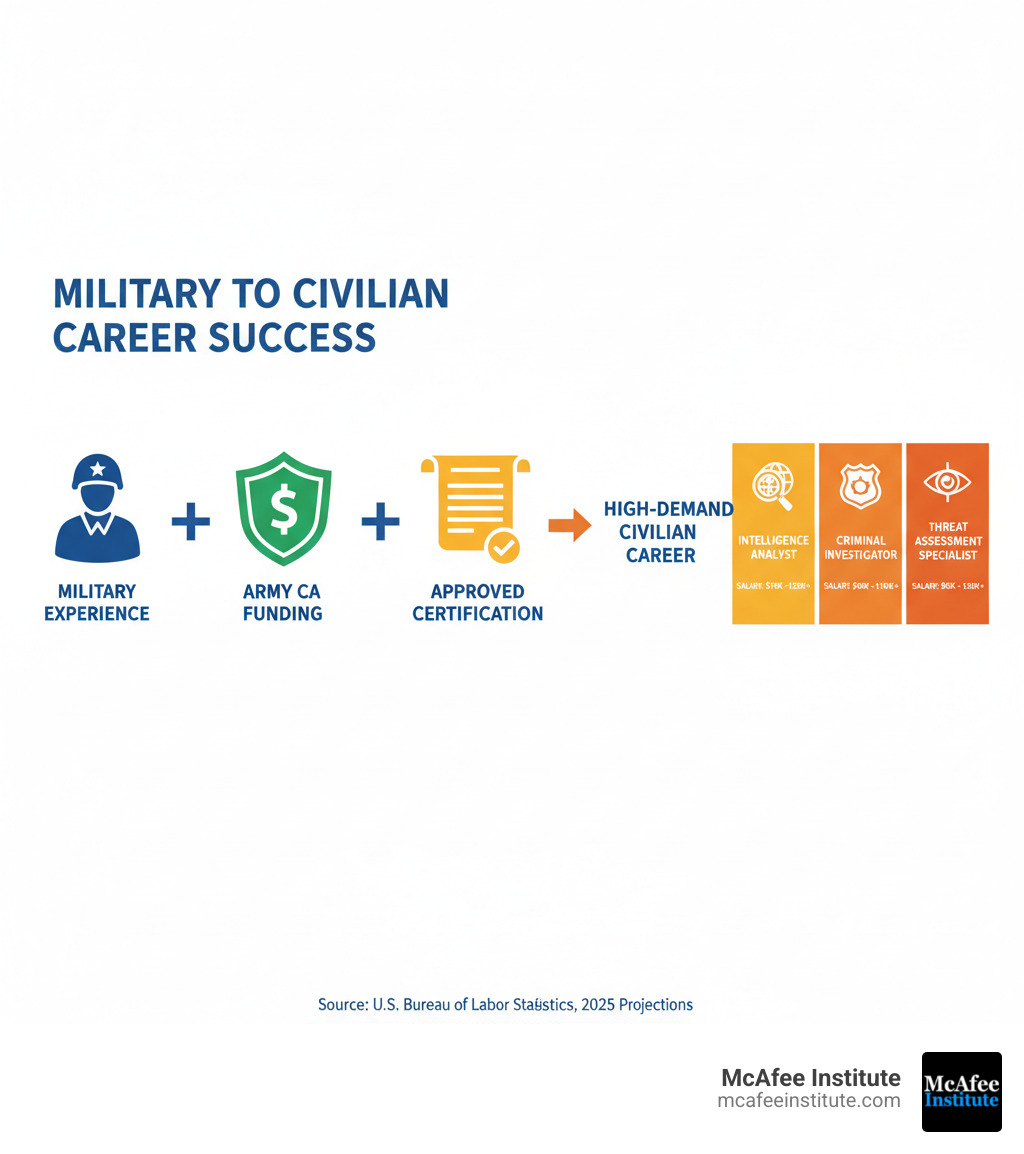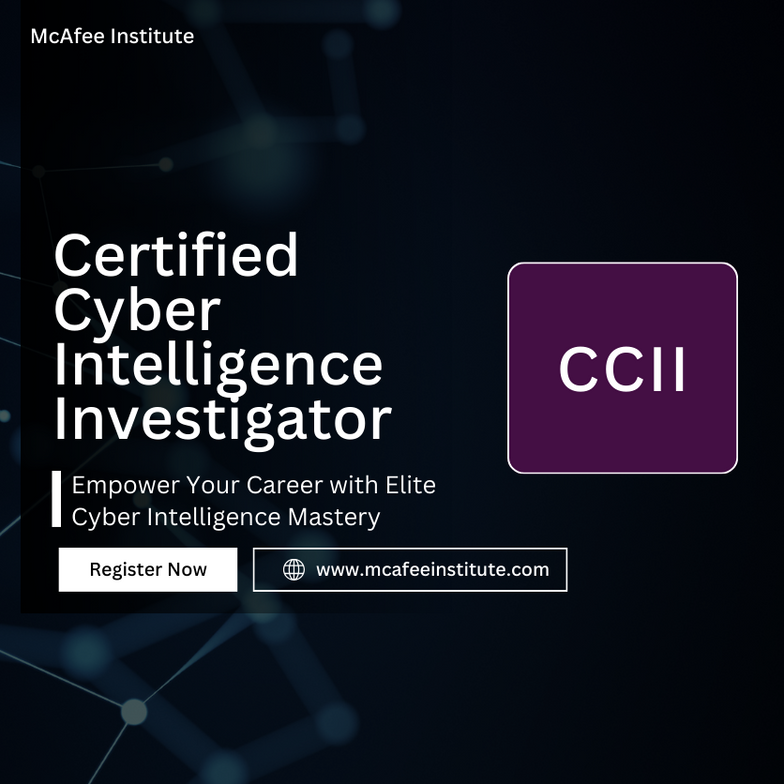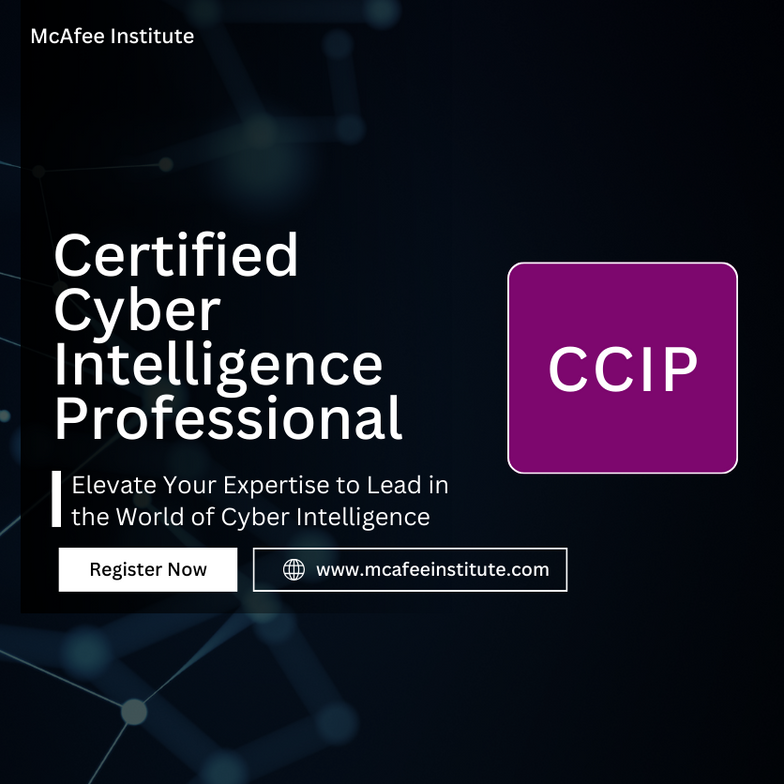Why Credentialing Assistance Approved Certifications Matter for Your Future
Credentialing assistance approved certifications are industry-recognized credentials that military service members can obtain using government funding to validate their skills for civilian careers. These certifications bridge the gap between military experience and civilian job requirements, making you immediately competitive in high-demand fields like law enforcement, intelligence, and investigations.
Quick Answer: Where to Find Approved Certifications
- Visit the Army COOL website to search by your MOS or civilian occupation
- Log into ArmyIgnitED through Login.gov to submit funding requests
- Choose from approved vendors like McAfee Institute that offer lifetime access and government-recognized credentials
- Access up to $4,000 annually to cover courses, exams, and study materials
Transitioning from military service to a civilian career can feel overwhelming. You've spent years developing valuable skills—discipline, leadership, critical thinking, and operational expertise—but civilian employers don't always understand how your military experience translates to their needs. A hiring manager might not grasp that your role as a platoon sergeant involved complex project management, risk assessment, and personnel development. That's where credentialing assistance approved certifications become your competitive advantage, acting as a universal translator for your hard-earned skills.
The Army Credentialing Assistance (CA) program offers a clear, funded path forward. It provides funding specifically for certifications that civilian employers recognize and value. Unlike traditional college degrees that take years to complete and offer broad knowledge, these certifications are focused, practical, and designed to get you hired quickly in specialized fields like intelligence analysis, criminal investigations, and threat assessment.
The reality is stark: By 2025, American employers will have 62 million high-quality job openings but only 39 million qualified workers with the right credentials. This 23-million-person gap, driven by rapid technological change and evolving global threats, represents your opportunity. Military veterans are uniquely positioned to fill these roles due to their inherent discipline and problem-solving abilities. However, you need the right certifications to formally validate that expertise and stand out in a competitive market.
Here's what makes credentialing assistance approved certifications a powerful tool for your transition:
Career-Specific Focus: Instead of general education, these certifications target the exact skills employers are hiring for right now. A degree in criminal justice provides a foundation, but a certification in Open-Source Intelligence (OSINT) proves you have the specific, hands-on skills to be an effective analyst from day one.
Fast-Track Timeline: You can complete a high-impact certification in a matter of weeks or months, not years. This rapid turnaround means you can become qualified for a new career field while still on active duty, positioning you for immediate employment upon transition.
Zero Out-of-Pocket Cost: The CA program provides up to $4,000 per year to cover all associated costs, including training, study materials, and exam fees. This removes the financial barrier to entry, allowing you to invest in your future without touching your personal savings.
Immediate Job Market Value: Certified professionals are often fast-tracked through the hiring process and can command higher starting salaries. Listing a government-recognized credential on your resume instantly signals to recruiters that you possess a verified and valuable skill set.
Lifetime Professional Recognition: These credentials belong to you and follow you throughout your career, across different jobs and industries. They demonstrate a commitment to your profession and to lifelong learning, which is highly respected by employers.
Whether you're preparing for retirement, looking to transition mid-career, or planning your post-service life years in advance, these certifications transform your military experience into credentials that hiring managers immediately understand and respect.
I'm Joshua McAfee, founder and CEO of McAfee Institute, where I've spent over two decades helping law enforcement, military, and intelligence professionals advance their careers through government-recognized credentialing assistance approved certifications that deliver real-world impact. After building Amazon's Loss Prevention program and training teams globally to combat organized retail crime and internal threats, I saw a need for practical, cutting-edge training. I created certification programs specifically designed for professionals who serve on the front lines of protection and investigation, ensuring they have the skills to succeed in any environment.
How to choose the right credential for your next role:
- Clarify your target job title and daily responsibilities (for example, intelligence analyst, criminal investigator, or threat assessment specialist).
- Verify the credential is listed on Army COOL and aligns with either your MOS or your desired civilian occupation.
- Compare vendors on training depth, instructor support, exam inclusion, and whether they offer lifetime access and updates.
- Map each certification to a tangible outcome you can put on your resume (for example, case development, OSINT collection and analysis, interview and interrogation, or financial crime investigations).
- Plan your timeline from request to exam so your credential is complete before terminal leave or retirement.
Translating your experience so it lands with employers:
- Led a platoon or section → Project planning, risk management, personnel development, and accountability measurable in timelines and outcomes.
- Conducted HUMINT/OSINT collection or analysis → Research methodology, structured analytic techniques, report writing, and stakeholder briefings.
- Managed evidence, incidents, or force protection tasks → Investigative process, documentation standards, and threat assessment.
Practical timeline example:
- Weeks 1–2: Identify your credential on COOL and confirm vendor fit.
- Weeks 3–6: Submit your request in ArmyIgnitED and plan your study schedule.
- Weeks 7–12: Complete training modules, use instructor support, and schedule your exam.
- Week 12+: Add the credential acronym and full name, issuing body, and year earned to your resume and LinkedIn.
This structured approach—backed by government funding and employer-trusted credentials—lets you turn years of military excellence into a civilian career trajectory with momentum from day one.

Understanding the Army Credentialing Assistance (CA) Program

Making the jump from military service to civilian employment shouldn't feel like learning to speak a foreign language. But let's be honest—many hiring managers don't automatically understand how your military training translates to their open positions. That's exactly why the Army Credentialing Assistance Program exists: to help you prove your expertise in terms civilian employers immediately recognize and value.
Think of Army CA as your professional translation service. It takes your military skills and experience and converts them into credentialing assistance approved certifications that open doors in the civilian job market. For example, instead of a resume bullet point that reads, "Conducted threat assessments during deployment," you can list a "Certified Threat Assessment Specialist" credential. The first requires explanation; the second gets you an interview.
What is Army CA and Who is Eligible?
The Army Credentialing Assistance program provides up to $4,000 annually to help active duty soldiers, Army Reserve members, and National Guard personnel earn professional and vocational credentials while serving. This isn't about getting another college degree—it's specifically designed for certifications that have immediate career value and demonstrate job-ready skills.
Here's what makes this program so powerful: you are not locked into pursuing credentials that match your current Military Occupational Specialty (MOS). This flexibility is a game-changer for career planning. If you're an infantry soldier with a passion for investigations, you can use CA funding to earn a Certified Professional Criminal Investigator (CPCI) credential. If you're in logistics but want to pivot to corporate intelligence, you can pursue a certification in Open-Source Intelligence (OSINT). This allows you to strategically build a bridge to your desired civilian career long before you hang up your uniform.
The funding covers everything you need to earn your certification: training courses, exam fees, study materials, books, and other required expenses. Whether you're strengthening skills in your current MOS to become a better leader or building expertise for your future civilian career, CA provides the financial support to make it happen without dipping into your own pocket.
Eligibility at a glance:
- Available to active duty soldiers, Army Reserve, and National Guard personnel, subject to Army policy and funding availability.
- Use the benefit to pursue credentials related to your MOS or aligned to your post-service goals.
- Requests are made and tracked in ArmyIgnitED; you can pursue more than one credential each year until the annual limit is reached.
Key Benefits and How it Differs from Tuition Assistance (TA)
Many soldiers initially confuse Credentialing Assistance with Tuition Assistance (TA), but they serve distinct and complementary purposes in your professional development. Understanding the difference is key to maximizing your benefits.
Tuition Assistance is for academic pursuits. It's designed to help you earn college degrees—associate, bachelor's, or master's—by paying for credit hours over traditional semesters. TA builds your broad educational foundation over several years.
Credentialing Assistance is for professional qualification. It's designed to get you job-ready with specific, marketable skills. CA funds focused training programs that result in an industry-recognized credential in weeks or months, not years. The goal isn't a diploma; it's a certification that proves your competency for a specific role, like an investigator, analyst, or project manager.
Think of it this way: TA helps you become more educated, while CA helps you become more employable. The beauty of CA is its laser focus on credentials that employers actively seek when hiring. When you list these on your resume, hiring managers see clear proof of your qualifications, eliminating guesswork.
The $4,000 annual funding limit provides substantial purchasing power in the certification world. Many high-value credentials—including specialized certifications in investigations, intelligence analysis, and law enforcement—fall well within this budget. This is where choosing the right vendor becomes critical. With lifetime access programs like those offered by McAfee Institute, you're not just getting a one-time exam voucher. You are turning your CA funding into a permanent career asset. This model provides you with permanent access to training materials, free course updates, and ongoing instructor support. In rapidly evolving fields like financial crime and intelligence, where tactics and technology change constantly, this ensures your skills and your certification remain relevant for your entire career, long after your initial training is complete. It maximizes the return on your educational benefits by eliminating future costs for recertification or update training.
Planning tip: submit your request as early as possible and ensure approval is in place before training starts. Many soldiers plan 45–60 days ahead so materials arrive on time and exam windows can be scheduled without rushing. Building a simple weekly study rhythm—backed by instructor support—helps you complete the credential on schedule and put it to work immediately in your transition plan.











Share:
Master the Digital Underworld: Essential Cyber Crime Investigation Training
The Mind Hunters: Behavioral Analysis in Modern Policing